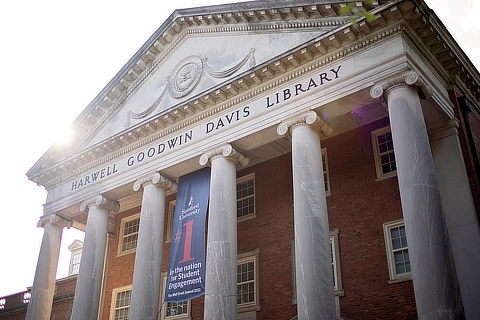
From civil rights to religious life, Black Alabamians have contributed to the history of the state since its founding in 1819. Samford University was founded as Howard College just 22 years later in 1841. As such, the university has watched the history of African Americans in Alabama unfold from slave labor on campus to the integration of Black students to the dedication of the Racial Reconciliation Memorial in 2022.
Harwell Goodwin Davis Library at Samford’s Special Collection and University Archives seeks to document the history of the university, the state of Alabama and its people, and Alabama’s religious institutions through the acquisition of historically significant, rare and unique materials.
“Preserving the records and artifacts we have in Special Collection is vital to telling the stories of those of who came before, to help us understand who we have become and help us to grow.” said Jennifer Taylor, chair of the Special Collection and University Archives, “We have records and artifacts that speak to the legacy of Black men and women and their journeys throughout the history of Samford and the state of Alabama.”
Among these items is one of the most influential pieces of text from the civil rights movement, two original copies of Rev. Martin Luther King’s “Letter from Birmingham Jail,” dated April 16, 1963. Which will be on display in the library throughout the month of February.
“Samford has a complicated and remarkable history with race,” said Denise Gregory, associate provost for student success and diversity and inclusion. “The legacy of black history here is heroic, brave, and central to Samford’s mission as a Christ-centered university.”
The legacy of the Black experience at Samford is filled with heroic stories and testimonies of perseverance. Today, some of the stories of these heroes and trailblazers are visible in campus monuments and tributes to African Americans who have made a profound impact on the university.
Several places on campus are dedicated in memory of Harry, an African American man who lived in slavery and died from injuries received while rousing the students at the burning of the Howard College building at midnight on Oct. 15, 1854. The college’s only building–which housed students, classrooms, laboratories, equipment and books–was destroyed by the fire. Harry woke up once the fire was discovered and went door to door waking students up.
Today, a plaque on Centennial Walk commemorates Harry’s life and heroism. Students enjoy concerts, meals and other special events in Harry’s Coffeehouse in the Beeson University Center. A monument funded by university officers and students still stands in the cemetery near the Siloam Baptist Church in Marion, Alabama, where Harry was buried.
In 1969, Elizabeth Sloan Ragland became the first Black student to integrate campus housing at Samford. Today, the Ragland Scholarship and Ragland Scholars program exist to cultivate academic and social support for Black, Indigenous and People of Color entering Samford. The students, faculty and staff that comprise the Ragland Scholars program aim to empower, foster and promote the leadership and academic excellence of Elizabeth Sloan Ragland.
Billy Williams, Sherman Hogan and Otha Mitchell joined Ragland in her trailblazing efforts, as Samford became the first major university in Alabama to integrate its sports teams when they joined the men’s basketball team.
In 2020, the university installed its Racial Reconciliation Memorial. In 2022, it was officially dedicated during a public worship service on campus. The memorial specifically honors the memory of Harry (1831-1854) and of Audrey Lattimore Gaston Howard (1940-1989) who, in 1967, became the first Black student admitted to Samford, and later went on to become the first Black female in the Southeast appointed to the U.S. Attorney’s Office.
The stories of the Black experience at Samford can also be seen in the university’s Special Collection and University Archives. Students and employees may visit Special Collections and University Archives Monday-Friday from 9 a.m.-5 p.m.; Samford guests must book an appointment for access to materials and are encouraged to contact Special Collection prior to making an appointment. However, several items in Special Collection are available for viewing online through the Digital Collections website.
“The department continues to grow in the records and artifacts collected. We are interested in collecting additional material that can help us better understand the past and present. We hope the materials placed online help not only the Samford community, but also researchers around the world seeking to understand and write about the history of Alabama,” said Taylor.
Celebrate Black History Month by joining Samford in several events and by exploring some of the history around campus and in the University Library.
View some of the items in the digital collection:
- Martin Luther King Jr.’s “Letter from Birmingham Jail,” view.
- Photo history of the Billy Williams, Sherman Hogan, Otha Mitchell and the integration of men’s basketball at a Samford pep rally, view.
- Photo history of the Billy Williams, Sherman Hogan, Otha Mitchell and the integration of men’s basketball at Samford, view.
- Photo history of Eric Motley, first Black Student Government Association president, and guest Gwendolyn Brooks, view.
- Photo history of Audrey Lattimore Gaston Howard, Samford’s first Black student, view.
- Photo history of the Lincoln Normal School, one of the first institutions established for the education of African Americans after the Civil War, view.
- Photo history of class photo of African American students and teachers, view.
- Photo history of Benjamin Sterling Turner, United States Representative (1871-1873), view.
- 1869 letter from Lotsey White, former slave inquiring on the whereabouts of various family members that had been sold off separately from herself, view.
- Tennessee Coal, Iron and Railroad Company Photographs Collection, which has ties to the Convict Lease System, view.
